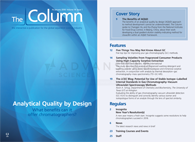The Benefits of AQbD
The benefits of an analytical quality by design (AQbD) approach to method development cannot be underestimated. The Column spoke to Changqin Hu and Xia Zhang from the National Institutes for Food Drug Control, in Beijing, China, about their work developing a dual-gradient elution stability-indicating method for cloxacillin within an AQbD framework.
Photo Credit: Vasya Kobelev/Shuttestock.com

The benefits of an analytical quality by design (AQbD) approach to method development cannot be underestimated. The Column spoke to Changqin Hu and Xia Zhang from the National Institutes for Food Drug Control, in Beijing, China, about their work developing a dual-gradient elution stability-indicating method for cloxacillin within an AQbD framework. - Interview by Kate Mosford
Q. Your group published a study on the development of a dual-gradient elution stability-indicating method for cloxacillin within an AQbD framework (1). What led your group to begin this study?
A: Cloxacillin represents a large number of drugs that are easily degraded and can produce many degradation-related impurities (DRIs) with variable polarities. It is often a challenge to develop selective and robust high performance liquid chromatography (HPLC) methods for these drugs to separate all DRIs effectively. Thus, the development of a stability-indicating method for impurity determination requires an in-depth understanding of the method. In this context, the concept of analytical quality by design (AQbD) is thought of as a tool for regulatory flexibility and robust analytics, and so it was applied to develop the stabilityâindicating method for cloxacillin.
Q. What benefits does this approach offer to chromatographers?
A: An AQbD approach provides the ability to assess robustness throughout the development process and to perform quality risk management when the method is transferred or the experiment variables are changed. It ensures a controlled risk-based development of the methods where quality assurance will be guaranteed and represents an advantageous alternative approach to the traditional quality by testing (QbT) approach or a one-factor-at-a-time (OFAT) process.
Q. Are there any misconceptions surrounding the role of AQbD in relation to chromatography?
A: We want to emphasize the importance of gathering prior knowledge and analyzing the results of preliminary experiments because they can provide significant information for the following steps. Some beginners often perform design of experiments (DoE) at the beginning, and they often get unsatisfactory results after the timeâconsuming implementation of the experiment runs. Such failures are often caused by a lack of prior knowledge and preliminary experiments.
Q. What advice can you offer to other scientists thinking of implementing AQbD in their research?
A: When we apply the AQbD approach to develop a chromatographic method, it is very important to implement the experiments step by step. The AQbD workï¬ow begins with an understanding of the analytical samples, followed by selection of the initial chromatographic parameters, definition of the analytical target proï¬le (ATP) and critical quality attributes (CQAs), risk assessments, screening of the experimental risk factors, and optimization of the experiment parameters. The end result is a robust analytical method with a well understood design space (DS) and method control strategy. Analysts should not copy another’s workflow completely, and they must understand the objective of each step to decide whether this step is needed in their experiment. If one step is omitted, analysts should be able to justify it.
Q. Were there any particular challenges that you faced during this research?
A: Yes. After the mix-process design was performed, no design spaces were obtained in which all the selected CQAs were satisfied. We were frustrated at first, but after an attentive analysis, we found that the CQAs could be classified into two groups according to their retention time: one included the separation factors for early eluted peaks B1/2, B2/3, and B3/A0, and the other included the later eluted peaks A3/1, A1/2, A2/M1, M1/M, and M1/2. Each group of CQAs could be satisfied in two different optimum regions. For peak pairs in Group 1, the optimum region was located in the region (a) where pH was close to 5.0 and the mixture composition covered a relatively wide range; for Group 2, it was located in the region (b) where both the acetonitrile content and pH were higher. This was also validated by performing two different chromatographic conditions in the region (a) and (b). This led us to use the dual gradient elution, which allowed the two optimum regions to be satisfied in the same chromatographic method by changing acetonitrile content and pH simultaneously. The dual gradient elution is therefore the key to building the design space for a cloxacillin stability-indicating method.
Q. Could this workflow be applied to other stability-indicating methods?
A: The AQbD approach and dual gradient elution method can be very powerful tools when developing HPLC methods for complex ionic samples. The AQbD workflow described in our paper could be advantageously applied to the development and improvement of any stability-indicating method. Based on our study, the following points are important when developing a stability-indicating HPLC method for other easily degraded drugs, such as penicillins:
- Gradient elution is more suitable to ensure the best retention of all penicillin DRIs than isocratic elution because both highly polar and nonpolar impurities are produced.
- For ion samples, such as penicillins DRIs, the most effective ways to vary separation selectivity are adjusting the pH or solvent type.
Q. What is your group working on at the moment?
A: We are applying the AQbD approach to the development of determination methods for other kinds of penicillins and cephalosporins to try to find the common rules for the satisfactory HPLC methods of these drugs whose structures and impurities are similar. We want to summarize a general workflow for the method development of penicillins and cephalosporins so that the suitable HPLC conditions for other similar penicillins and cephalosporins can be found quickly according to these common rules.
Reference
- X. Zhang and C. Hu, Journal of Chromatography A 1514, 44–53 (2017).

Changqin Hu is a full professor at the National Institutes for Food and Drug Control (NIFDC) in Beijing, China. Prof. Hu is in charge of more than 20 projects and his research interests lie in the development of a drug impurity profiling analytical platform, drug crystal forms analysis, the development and application of fast detection technologies in drugs, and the microbiological analysis of drugs. Prof. Hu has authored or coauthored more than 200 peer-reviewed papers and more than 10 books.

Xia Zhang received her Ph.D. as a joint training student of NIFDC and Peking Union Medical College in 2017. Her research work includes the selection of HPLC columns, the development of chromatographic methods, and theoretical calculations.
E-mail: hucq@nifdc.org.cn / s791657998@126.com
Website:http://www.nicpbp.org.cn/CL0001/

Common Challenges in Nitrosamine Analysis: An LCGC International Peer Exchange
April 15th 2025A recent roundtable discussion featuring Aloka Srinivasan of Raaha, Mayank Bhanti of the United States Pharmacopeia (USP), and Amber Burch of Purisys discussed the challenges surrounding nitrosamine analysis in pharmaceuticals.
Silvia Radenkovic on Building Connections in the Scientific Community
April 11th 2025In the second part of our conversation with Silvia Radenkovic, she shares insights into her involvement in scientific organizations and offers advice for young scientists looking to engage more in scientific organizations.

.png&w=3840&q=75)

.png&w=3840&q=75)



.png&w=3840&q=75)



.png&w=3840&q=75)










